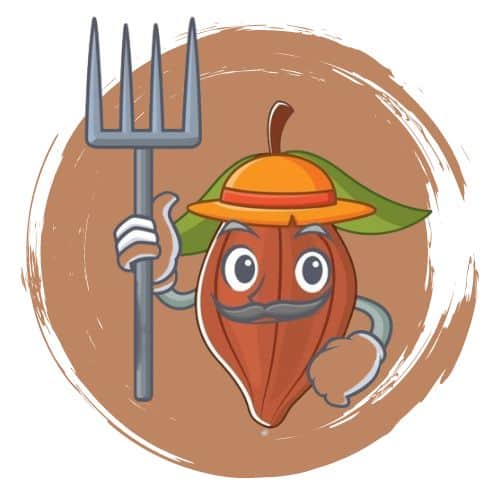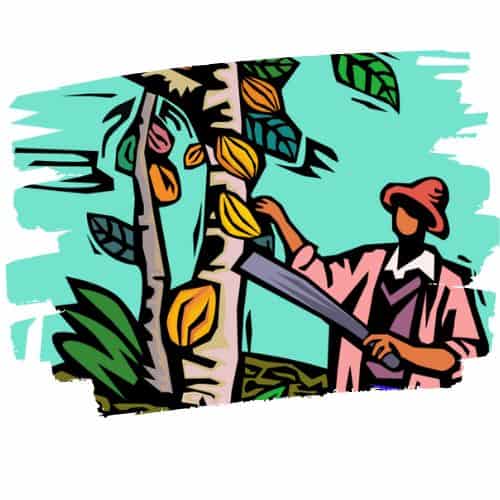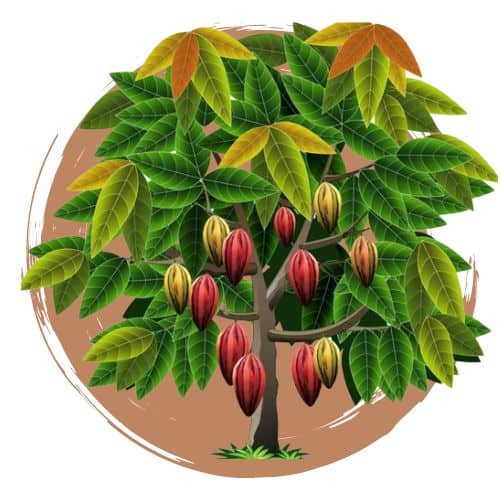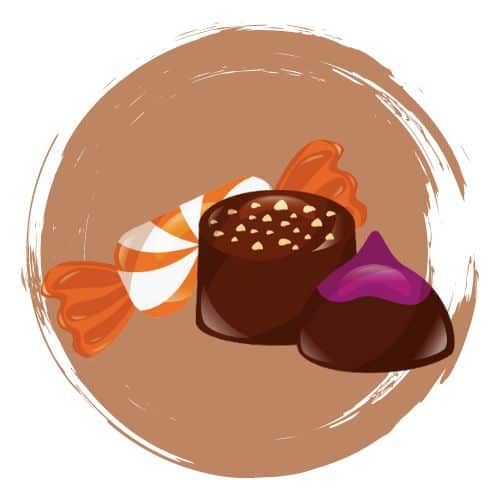West Africa is the best place to grow cocoa beans. However, it was first discovered in South America by the Aztecs and Mayans. Climate conditions that provide a lot of rain in Africa and hot and humid regions are ideal for cocoa growth.
While cocoa grows widely in West Africa today, few people are aware that it was first discovered as a crop in South American culture. Aztecs and Mayans were the first indigenous groups to grow and cultivate cocoa.
For centuries, cocoa was valued for its use as currency in trade, as post-battle rewards for warriors, and as the main ingredient of royal feasts.

During religious ceremonies, cocoa bean powder was used to make a signature drink. Today, this drink is known as a chocolate drink or xocoatl, which means “bitter water” in Nahuatl.
In this guide, I’ll take you through all you need to know about cocoa.
The History of cocoa beans

After his fourth expedition in 1502, Christopher Columbus brought cocoa beans to Spain. When the Spanish Conquistadors arrived in the New World and began invading, occupying, and eventually eliminating native societies, they discovered the value of the local cocoa crop.
Cacao residues on Ecuadorian pottery imply that humans consumed the plant as early as 5,000 years ago.
Cocoa beans were only consumed on religious occasions as “meals for the gods” at the time. Because cocoa was bitter, the Spanish conquistadors used sugar and spices to sweeten it. Following that, chocolate became extremely popular among the Spanish, who kept the production method a secret from the rest of Europe for about 100 years following their discovery.
However, the secret eventually traveled across Europe, including France and England. While it gained popularity in this country, hot chocolate was still consumed by the upper crust and eventually earned the reputation of being an aphrodisiac.
The uniqueness of chocolate was significantly eroded during the industrial revolution until it became popular among everyone who could afford it.
One aspect has stayed constant during its centuries-long history, and cocoa has attracted followers from all around the world. Over 4.5 million tonnes of cocoa beans are eaten globally. each year, in everything from drinks to candy bars. It’s safe to say that the ancient Mesoamericans who first cultivated cocoa could never have predicted its current appeal.
What is cocoa?

The cocoa bean is the seed of the cacao tree (Theobroma cacao), a tropical plant native to the Americas’ equatorial regions. The fluid paste, or liquor, from which cocoa powder and chocolate are formed is extracted from the processed cocoa bean.
Growing and harvesting cocoa beans
The cocoa tree is native to the tropics. It thrives in hot, humid climates around the world. It can grow up to 15 meters tall in the wild and can be found across Ecuador. This is rather short for these places, allowing the cocoa tree to benefit from the shade provided by other trees to mature appropriately.

The trunk can grow to be up to 30 centimeters wide.
On the environmental front, the cocoa tree requires deep and very fertile soil, as well as favorable climatic conditions with plenty of rain. This is why it grows at low altitudes, typically between 400 and 700 meters.
Conditions for cocoa to grow

Cocoa trees need some conditions to grow properly. These are;
- The cocoa tree needs an average temperature of 25°C to grow and it should never drop below 10°C.
- The annual rainfall should be between 1,500 and 2,500 mm.
- The humidity level should be 85%.
- Dry periods should not exceed three months.
- The cocoa tree can grow up to 1,000 m (when under the equator). It can only grow at sea level at latitude 20° north or south.
When the cocoa is ripe, the ripe seed pods are cut from the trees and cracked apart with machetes. To maximize yields, both expertise and human interaction are required. As a result, harvesting is typically done by hand in two parts. Harvesters first cut the pods from the tree to enable them to fall, then open them to get the cocoa beans from the inside.
The beans are pulled from the pods along with the pulp and piled in leaf-covered heaps, leaf-lined holes dug in the ground, or big shallow boxes with perforated bottoms to allow for drainage. Cocoa harvesting occurs from October to February and from May to August each year.
In Ivory Coast, for example, there is a distinction between the “great harvest,” which takes place from October to February, and the “little harvest,” which takes place from March to June.
Even though the Maya were the first to use it, the majority of cocoa tree production is centered in the Ivory Coast, which accounts for more than a third of global production. Other key generating regions are Asia and North America.
The juicy sweatings of the pulp are drained away during fermentation, the germ in the seed is killed by the increased heat, and flavor development occurs. The beans grow plump and moist, and the interior develops a reddish-brown color and a strong, sharp aroma.
The fermented beans are sun-dried or kiln-dried to reduce the moisture content to 6–7% and bagged for sale.
Following fermentation, cocoa beans are dried for 5-7 days in the sun or in a specially designed heated oven. The roasting procedure is subsequently initiated. Roasting enhances flavor, reduces acidity and astringency, reduces moisture content, deepens the color, and makes shell removal easier.
Following roasting, there is a breaking and winnowing process in which machines crack the shells and then separate them from the heavier nibs using blowers. Grinding breaks down the cell walls of the nibs, releasing the fat, or cocoa butter, and generating a paste known as chocolate liquor, or cocoa mass.
Cocoa beans have a somewhat acidic pH range of 5.2-5.8. When the pH remains constant, the beans yield pleasantly sharp flavors that combine well in a variety of dishes and confections.
What are the different types of cocoa trees?
There are three main categories of cocoa trees in the traditional classification of world crops: Criollo, Trinitario, and Forastero. Each of these trees produces beans that are used in a variety of ways, depending on their properties and the conditions in which they are grown.
1. The Criollo cocoa tree

Criollo cocoa trees are distinguished by the flavor of their beans. This cacao tree family is highly valued by chocolatiers for the production of high-end products.
The Criollo tree group chocolate is not bitter, has a robust aroma, and has a fantastic refinement on the taste. Although the sweet flavor of these beans is valued in the industry, farmers do not grow them in big amounts since the trees are frail and sensitive to disease.
Today, this form of the cocoa tree is far less common in the cocoa market, accounting for only 0.1% of global production when compared to other varieties. Criollo beans, on the other hand, ferment quickly. Vegetative propagation is a typical technique of reproduction in cocoa trees.
2. The Trinitario cocoa tree

The Trinitario cocoa is most likely a cross between a Criollo and an Amazonian Forastero. The quality of their cocoa and their distinguishing characteristics appear to imply that they are the consequence of a subtle blending of these two groups.
The color of the beans, the size of the trees, and the shape of the pods can all differ depending on the Trinitario species.
Chocolate manufacturers like the elusive and slightly intermediate botanical character of this group of cocoa trees. The Trinitario cocoa tree accounts for between 10% and 15% of all cocoa-producing trees worldwide.
Many countries cultivate various types of this group of trees, including Venezuela, Brazil, Mexico, and Cameroon.
The Trinitario trees, like the Criollo, have crimson pods that turn orange as they ripen. One tree produces approximately 150 pods each year, which is equivalent to approximately 6 kilograms of cocoa.
3. The Forastero cocoa tree

This is without a doubt the most cultivated set of cocoa trees in the world. Indeed, it accounts for 80% to 90% of global cocoa production. Because of their disease resistance and rapid maturation, Amazonian Forastero is very common in cocoa fields. Other advantages of this species of cocoa tree include its vigor and excellent yield.
West Africa, Central America, North and South America, Brazil, and Ecuador are all home to Forastero trees. This variety of cocoa trees may become more extensively grown in the future due to its high yield and simplicity of cultivation.
Most Forastero cocoa beans are rated “standard,” but the Ecuadorian type gives excellent cocoa quality.
This tree species is distinguished by its smooth yellow and green pods, purple-colored nuts, and bitter cocoa flavor. The chocolate beans from these cacao trees are high in tannin. Each pod of this tree has 30 to 40 cocoa beans.
The origin of cocoa powder

Cocoa powder is a highly concentrated powder formed from chocolate liquor—a paste made from cocoa beans, the fruit of the cacao tree—that is used in beverages and as a flavoring agent. Cocoa is the primary component of chocolate and chocolate confections.
Cocoa powders are formed by decreasing cocoa cakes, which are made by hydraulically pressing chocolate liquor with a cocoa butter level of approximately 53 to 56%.
The amount of cocoa butter left in the powder can range from 8 to 36%, with the most typical commercial grades in the US containing 11, 17, or 22% cocoa butter. In the United Kingdom, cocoa sold for beverage purposes must contain at least 20% cocoa.
Chocolate is sold directly to customers in the form of solid bars of eating chocolate, packaged cocoa, and baking chocolate. Chocolatiers use it as a coating for candy bars and boxed or bulk chocolates, bakery product producers and bakers use it as a coating for many different types of cookies and cakes, and ice cream companies use it as a coating for frozen novelties.
Cocoa powders, chocolate liquor, and their blends are used in bulk to flavor a variety of culinary goods and to provide flavoring in “chocolate” products such as syrups, toppings, chocolate milk, prepared cake mixes, and medications.
C.J. van Houten of the Netherlands patented a method for producing “chocolate powder” in 1828 by pressing much of the cocoa butter from the ground and roasting cocoa beans. Fry and Sons of England blended cocoa butter, a byproduct of the pressing, with chocolate liquid and sugar to make eating chocolate in 1847, while Daniel Peter of Switzerland added dried milk to make milk chocolate in 1876. Flavored, solid, and coated chocolate dishes proliferated quickly after.
Making chocolate products with cocoa beans

Chocolate products typically involve the addition of extra cocoa butter to the cocoa liquor. Chocolate is available in consumer-size packets as well as big bulk amounts for use by food producers and confectioners.
Most European chocolatiers produce thrown chocolate; others purchase chocolate from chocolate specialists. Chocolate is carried warm and liquid in heated sanitary tank trucks or tank cars for large commercial orders.
Types of chocolate
1. Baking chocolate

Baking chocolate, also known as bitter chocolate, is a pure chocolate liquid prepared from finely ground nibs, which are broken fragments of roasted, shelled cocoa beans. This chocolate is bitter since it contains no sugar and can be natural or alkalized.
2. Sweet chocolate

Sweet chocolate is often dark in color and prepared with chocolate liquor, sugar, additional cocoa butter, and flavorings such as vanilla beans, vanillin, salt, spices, and essential oils. Sweet chocolate typically comprises at least 15% chocolate liquor, with the sweetest chocolate being 25-35%.
Blended, refined (processed to a smooth mass), and conched ingredients More cocoa butter, lecithin (an emulsifier), or a combination of the two is then added to modify the viscosity.
“Bitter chocolate,” on the other hand, can refer to either baking chocolate or bittersweet chocolate. Bittersweet chocolate is similar to sweet chocolate except that it includes less sugar and more chocolate liquor. In some countries, like the United States, minimum amounts of chocolate liquor are required by law.
3. Milk chocolate

Milk chocolate is made by substituting whole milk solids for a portion of the chocolate liquor used in sweet chocolate production. It is typically made out of at least 10% chocolate liquor and 12% whole milk solids.
Manufacturers regularly exceed these limits, going as high as 12-15% chocolate liquor and 15-20% whole milk solids. Milk chocolate, which is often lighter in color than sweet chocolate, has a sweeter or softer flavor due to a lower proportion of bitter chocolate liquor. The manufacturing process is identical to that of sweet chocolate.
What is the nutritional value of Chocolate?
Cocoa, a high-calorie meal with about 1,000 calories per kilogram, contains carbohydrates, fat, protein, and minerals. It has a somewhat stimulating impact due to theobromine and caffeine content. Chocolate’s carbs and quickly digested fats make it an ideal high-energy snack.
Frequently Asked Questions (FAQs)
Where do cocoa beans grow?
The Ivory Coast, Nigeria, Cameroon, and Ghana are the top producers of cacao- 70% of the world’s cocoa beans come from these West African countries. However, countries such as Indonesia, Peru, Venezuela, and many countries in Central America and the Caribbean also grow beans.
Can cocoa be grown anywhere?
Regardless of its first home, we know the cacao tree is strictly a tropical plant, thriving only in hot, rainy climates. Cocoa can only be cultivated within 20 degrees north or south of the equator. The Need for Shelter The cacao tree is quite delicate.
Can you grow cocoa plants in the US?
Growing cacao trees requires mimicking these conditions. In the United States, that means the tree can only be grown in USDA zones 11-13 – Hawaii, parts of southern Florida, and southern California, as well as tropical Puerto Rico.
What states grow cocoa beans?
Southern Florida and Hawaii come to mind. Hawaii sits just south of 20 degrees north latitude, neatly within the Cocoa BeTherehere is a burgeoning chocolate industry happening in Hawaii today.
How many years does it take cocoa to grow?
Cocoa trees are only likely to flower when they’re four to six years old and about five feet tall, and during this time they need to be grown in optimal conditions. After this, it then takes five to six months for the cacao pods to ripen from the pollinated flowers.
Can I grow a cocoa tree in my house?
It’s only about 6 feet tall but produces well. Cacao trees are zone 10 plants, so they want to be kept warm, but they will grow just fine at room temperature in a normal house. Keeping them consistently between 65 and 70 degrees is sufficient for them to thrive.
Now Your turn
Temperatures that are hot, humid, and tropical are ideal for growing cocoa. It is for this reason that cocoa beans grow best in West Africa.
Today, cocoa beans represent one of the world’s greatest resources, just as they were when they have discovered thousands of years ago.
Chocolate butter and cocoa powder are two of the most notable products produced from cocoa beans. Due to their nutritional and therapeutic benefits, these two products are widely valuable.
Tell us what you think is the best thing about cocoa beans.
